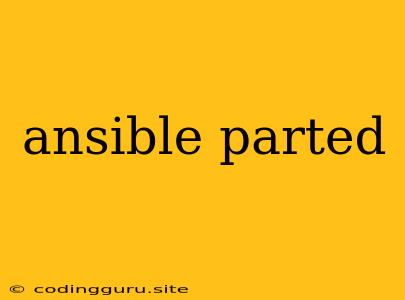Managing Disk Partitions with Ansible and parted: A Comprehensive Guide
Ansible is a powerful automation tool for managing infrastructure. parted is a versatile command-line utility for manipulating disk partitions. This guide will explore how to use Ansible to effectively manage disk partitions with parted.
Why Use Ansible with parted?
Integrating parted with Ansible provides several advantages for managing disk partitions:
- Automation: Automating partition management tasks reduces manual errors and ensures consistency across multiple systems.
- Scalability: Ansible allows you to easily manage partitions on a large number of servers simultaneously.
- Idempotency: Ansible playbooks are idempotent, meaning they can be run multiple times without altering the system's state. This ensures predictable outcomes.
- Flexibility: parted offers extensive functionality, enabling you to create, resize, delete, and format partitions.
Creating Disk Partitions with Ansible and parted
Ansible uses modules to interact with systems. For managing partitions, we'll utilize the "parted" module. Let's explore a practical example:
Task: Create a new primary partition on /dev/sdb with a size of 10GB.
Ansible Playbook:
---
- hosts: all
become: true
tasks:
- name: Create a new primary partition on /dev/sdb
parted:
device: /dev/sdb
number: 1
size: 10GB
mklabel: gpt
mkpart: primary
mktype: 83
state: present
Explanation:
become: trueensures the playbook executes with elevated privileges.device: Specifies the disk device.number: Defines the partition number.size: Sets the partition size in GB.mklabel: Creates a new partition table (GPT in this case).mkpart: Creates a new primary partition.mktype: Assigns a partition type (83 for Linux).state: presentensures the partition exists.
Resizing Disk Partitions
Ansible allows you to resize partitions by providing the desired size parameter.
Task: Resize the existing partition 1 on /dev/sdb to 20GB.
Ansible Playbook:
---
- hosts: all
become: true
tasks:
- name: Resize partition 1 on /dev/sdb to 20GB
parted:
device: /dev/sdb
number: 1
size: 20GB
state: present
Deleting Disk Partitions
To remove a partition, set the state to absent.
Task: Delete partition 1 on /dev/sdb.
Ansible Playbook:
---
- hosts: all
become: true
tasks:
- name: Delete partition 1 on /dev/sdb
parted:
device: /dev/sdb
number: 1
state: absent
Advanced Partition Management with Ansible and parted
Ansible and parted support advanced partition management tasks:
- Formatting Partitions: You can format partitions using the
mkfsmodule with various filesystem types (e.g., ext4, xfs). - Partition Alignment: parted can align partitions to specific sector boundaries for optimal performance.
- Partition Flags: You can set partition flags like
bootandlba. - Scripting Complex Operations: Create complex partition management workflows using Ansible playbooks and parted commands.
Best Practices for Ansible and parted
- Test Thoroughly: Always test your Ansible playbooks in a non-production environment before deploying them to critical systems.
- Backups: Ensure you have backups of your data before making any changes to disk partitions.
- Documentation: Clearly document your Ansible playbooks and the partition management strategies you've implemented.
Troubleshooting Tips
- Permissions: Ensure you have the necessary permissions to execute parted commands.
- Device Identification: Verify the correct device name for the disk you're targeting.
- Partition Table: Check the existing partition table using
parted -l. - Error Messages: Carefully examine error messages from Ansible and parted for clues.
Conclusion
Utilizing Ansible and parted effectively streamlines disk partition management, automating tasks, enhancing scalability, and ensuring consistency across your systems. By understanding the capabilities of these tools and implementing best practices, you can confidently manage your disk partitions with precision and efficiency.
